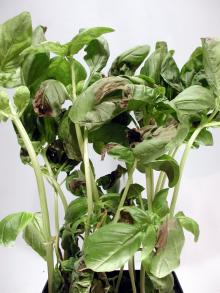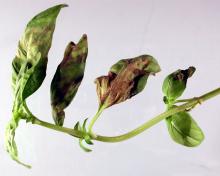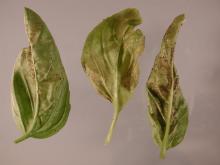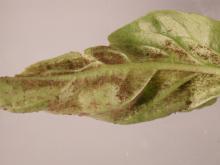Cause An oomycete, Peronospora belbahrii, that can be spread through contaminated seed and produces airborne spores, which can disperse and spread disease. The first United States report (October 2007) was from the Southeastern United States. Basil downy mildew was found in many states, including California, during 2009 and by 2011, it was discovered in Oregon. By 2014, it was reported in 35 US states. It can be a problem in both field- and greenhouse-grown basil crops, as well as in home gardens. Downy mildew is promoted by leaf wetness as well as high relative humidity, but can develop under a wide temperature range.
Symptoms Disease appears on the older leaves initially. Affected leaves have a yellowing or lighter green color, which resembles a nutritional deficiency, and on the undersurface of an affected leaf, purplish-brown sporulation can be observed. Affected leaves turn wholly yellow and then fall off. Brown leaf spots may develop as secondary pathogens attack leaves weakened by downy mildew.
Sampling Seed stock can be assayed for the causal organism in official tests conducted by:
Eurofins STA Laboratories (1821 Vista View Drive, Longmont, CO 80504; Tel: 303-651-6417; Fax: 303-772-4003; Customer Service: 800-426-9124; Email: stacoinfo@eurofinsus.com)
Cultural control
- Plant seed not infested with the basil downy mildew pathogen, use steam-treated seeds if available.
- Time irrigation and plant spacing to promote aeration and minimize leaf wetness and reduce relative humidity.
- Control greenhouse humidity with fans, lights, and increasing temperature.
- Bury or destroy infected plants after the final harvest, to reduce spores in the air. Disturbed spores can be killed by the UV radiation of bright sunlight.
- Variety evaluations to date have shown that sweet basil (Ocimum basilicum) is very susceptible while Ocimum citriodorum and Ocimum americanum are more resistant. Plant a less susceptible variety:
Susceptible All sweet basil varieties were found to be highly susceptible in a screening by Cornell and inlcude O. basilicum varieties: 'Amethyst Imp', 'Aroma 2', 'Cinnamon', 'Gecofure', 'Genovese', 'Genoveser Martina', 'Italian Large Leaf', 'Magical Michael', 'Mariden', 'Nufar', 'Opal Purple Variegated', 'Poppy Joe's', 'Queentette', 'Rubin' and 'Superbo'.
Moderately Resistant O. basilicum red type varieties: 'Red Leaf'and 'Red Rubin'; O. citriodorum lemon basil type varieties: 'Lemon', 'Lemon Mrs. Burns', and 'Lemona'; Thai basil variety: 'Queenette'; and O. sp lime type variety: 'Lime'.
Highly Resistant O. basilicum spice type variety: 'Blue Spice Fil'; O. sp variety: 'Spice'; O. basilicum x americanum variety 'Blue Spice'.
Chemical control Fungicides are a primary management practice for commercial production.
- Badge SC (Group M1) at 0.75 to 1.5 pints/A on 7- to 10-day intervals. Preharvest interval is 0 days. 24-hr reentry for green-house use; 48-hr reentry for all other applications.
- Orondis Ultra (Group 49 + 40) at 5.5 to 8 fl oz/A on 7- to 10-day intervals. Preharvest interval is 1 day. 4-hr reentry.
- Oxidate at 40 to 128 fl oz/100 gal water on 5-day intervals. Efficacy unknown. 1-hr reentry.
- Phosphonates formulations (Group P7; formerly Group 33) are effective.
- Fosphite at 1 to 3 quarts/100 gal water/A on 14- to 21-day intervals. 4-hr reentry.
- K-Phite 7LP at 1 to 3 quarts/100 gal water/A on 14- to 21-day intervals. 4-hr reentry.
- Helena ProPhyt at 3 to 4 pints/A on 7-day intervals. 4-hr reentry.
- Quadris Flowable (Group 11) is labeled for use on basil for other diseases but will only suppress downy mildew. Not for use in the greenhouse.
- Ranman 400SC (Group 21) at 2.75 to 3 fl oz/A on 7- to 10-day intervals. Alternate to a fungicide with a different mode of action. Studies by Cornell showed good disease control in field-grown 'Genovese' basil when this material was alternated with Revus. Can be applied to basil grown in a greenhouse. Preharvest interval is 0 days. 12-hr reentry.
- Regalia (Group P5) at 1 to 4 quarts/A plus another fungicide on 7- to 10-day intervals. Does not benefit from the addition of an adjuvant. Preharvest interval is 0 days. 4-hr reentry. O
- Revus (Group 40) at 8 fl oz/A on 7- to 10-day intervals. Make no more than two (2) applications before alternating to a different mode of action. Preharvest interval is 1 day. 4-hr reentry.
- Trilogy as a 1% solution on 7- to 14-day intervals before infection. Not labeled for use in Oregon. Do not use above 90°F or when plants are under heat or moisture stress. Do not use when foliage is wet as good coverage is essential. 4-hr reentry. O
- Vacres (potassium bicarbonate) at 2.5 to 5 lb/A on 7- to 14-day intervals. Preharvest interval is zero (0) days. 4-hr reentry.
Biological control Efficacy unknown in the Pacific Northwest.
- Actinovate AG at 3 to 12 oz/A on 7- to 14-day intervals will suppress downy mildew. 4-hr reentry. O
- Actinovate Lawn & Garden at 1/2 to 1 teaspoon/gal water. H O
- Rootshield WP at 3 to 8 oz/100 gal water for greenhouse soil drench and field chemigation, or at 16 to 32 oz/A as an in-furrow spray. 4-hr reentry. O
- Stargus at 2 to 4 quarts/A plus a nonionic surfactant on 7- to 10-day intervals. Preharvest interval is 0 days. 4-hr reentry. O
References Blomquist, C.L., Rooney-Latham, S., and Nolan, P.A. 2009. First report of downy mildew on field-grown sweet basil caused by a Peronospora sp. in San Diego County, California. Plant Disease 93:968.
McGrath, M.T., and Sexton, Z.F. 2017. Evaluation of biopesticides and an organic copper fungicide for downy mildew in sweet basil, 2016. Plant Disease Management Reports 11:V030.
Wyenandt, C.A., Simon, J.E., McGrath, M.T., and Ward, D.L. 2010. Susceptibility of basil cultivars and breeding lines to downy mildew (Peronospora belbahrii). Hortscience 45(9):1416-1419.





